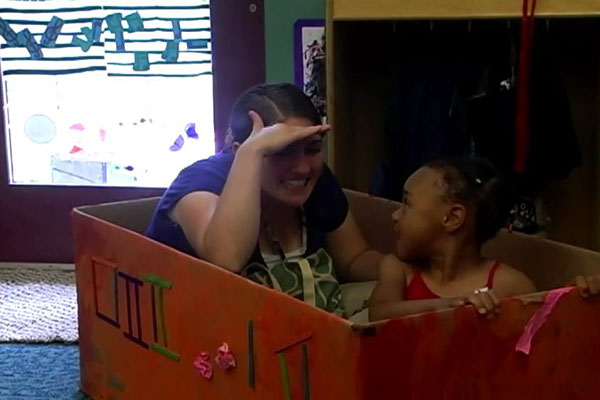The Train Station: A Child-Created
Teacher-Facilitated Dramatic Play Center
Download a printable English transcript or Spanish transcript.
Narrator: Teachers often design their play centers based around children’s interests. Some children need a little bit of support in order to play. In these instances, teachers often choose to actually enter the dramatic play area and play along with children.
Dr. Jeffery Trawick-Smith, Eastern Connecticut State University: One way to enhance children’s pretend play is to get children involved in the planning of the play center and the play theme. Often, teachers will engage children in creating props, and thinking through how props and space should be arranged.
Amy Doyle, Preschool Teacher: In my classroom, to decide a dramatic play center we involved the children, so we talked about what types of dramatic play centers they might like to have and the children really geared toward a train station. To determine their background knowledge on the train station we started by webbing the topic together as a whole group and from that you can really see which children have the knowledge or which children are looking to their peers to help them out. From this experience we learn that two children, out of the whole class, have been to a train station before and had the experience of riding on a train, whereas the rest of the children had no knowledge of that at all; so from there we did the research on the computer and looked at the virtual field trip so the children could understand exactly what happens in a train station. Our goal for this was for children to not only gain the knowledge of the train station, some content knowledge of that, but it was also for them to work together through the whole process and the children helped to create all the props for that center; they created the train themselves, they created the cash register, and the tickets, and the money that they would use there. One child shared her whole experience with us; when she went to get on the train there was this big, yellow area that she was not allowed to step on so she had to stay behind it until the train came, and came to a stop and that really sunk in to another child and she realized that we didn’t have a yellow space in the dramatic play center.
Amy: Explain to me again what the yellow tape means. What does yellow mean next to the train?
Child: You step on the yellow it means you will slip your feet up.
Amy Doyle: Our dramatic play center was a good opportunity for me to join the children and really scaffold and model and show what appropriate things we could do there.
Amy: I am the customer and who are you going to be, Elise?
Child: I’m being the cash register.
Amy: You are the cash register? I thought that this was the cash register. Who are you?
Child: What does that mean when you pay someone?
Amy: A cashier?
Child: I’m the cashier.
Amy Doyle: After observing the children I learned to really pay close attention to how we model the center and what roles we really talk about.
Amy: And what’s Asia’s job?
Child: Asia’s job is to drive.
Amy: To drive the what?
Child: Train.
Amy: What is that called? What are those people called that drive a train?
Amy Doyle: Children are still working on their cooperative play skills so it’s really my job to step in and scaffold the children or encourage the peer-to-peer interactions and there’s also the emotional piece; there’s a problem is going to arise at some point.
Child: Wait, that’s my baby. I have to hold her.
Amy: Talk to her calmly.
Child: That’s my baby and I have to hold her.
Amy: I think she was just trying to help you. Notice the baby was by itself.
Amy Doyle: We always look for cooperative play and empathy and how they’re playing together.
Child 1: I should have brought extra clothes.
Child 2: I’ll go find you some extra clothes, okay?
Child 1: Are you okay?
Child 2: Yes.
Amy Doyle: In the center, there’s so much social studies going on. The children were buying tickets and they had the exchange of money and they know all the responsibilities of each role. They knew as a mother what their job was.
Child: Yeah that’s really far away, I’m going to have to take a stroller.
Amy Doyle: They knew as a cashier what their responsibilities were.
Child: It costs five dollars please.
Amy: Five dollars… do you know where I am going?
Amy Doyle: And there was a certain point where we needed a doctor.
Child 1: She’s the doctor.
Child 2: I work at the train station.
Amy Doyle: And they had the opportunity for so much symbolic representation using the box as a train, using the paper towel tube as a phone, becoming the sounds of the alarm clock when it was someone to get up.
Amy: What is that noise?
Amy Doyle: Children learn through play, through hands on play, so dramatic play is a great area for them to learn so many different things.



